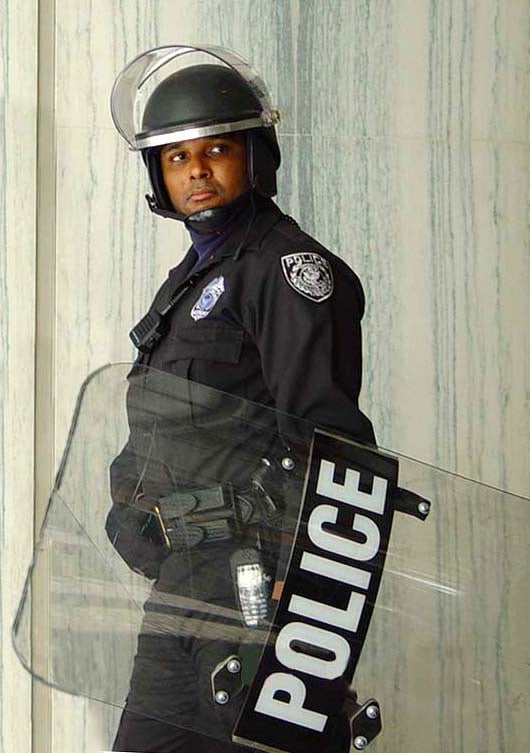As domestic threats continue to increase, so does the need for better protection for law enforcement officers (LEOS). While many advances have been made since the first bullet-resistant vests were developed, it should be noted that the vests worn by most patrol officers or regular duty officers do not stop every type of bullet, nor is any vest entirely bulletproof.
What is Body Armor?
Bullet-resistant vests, also know as ballistic vests or body armor, (body armor can also be used to describe helmets, leg and arm protection) are the reason many people are alive today. According to the National Institute of Justice (NIJ) in a 2013 report:
“During the past three decades, ballistic-resistant soft body armor has saved the lives of more than 3,000 police officers.”
There are two basic categories for body armor: hard and soft. Soft is worn by most officers and stops most handgun bullets. Hard body armor provides protection from faster-moving ammo such as rifle rounds.
Today, most regular duty officers wear vests that consist of a carrier (the fabric part) with pockets that contain bullet-resistant, removable panels. Threat Level IIIA vests typically weigh between 5-6 pounds.
The Evolution of Body Armor
Early vests date back to the 1500s in Italy. They were very heavy and made from several layers of metal. The Japanese improved on this design in the 1800s by making fairly effective vests out of silk. Then came WWII’s bulky, heavy, flak jacket. Ballistic protection technology made a huge leap forward in the 1960’s-70’s with the introduction of modern body armor, was a game changer because it was deemed truly bullet resistant.
Types of Protection for Different Law Enforcement Roles
Because they face different kinds of threats, LEOs are issued vests that fit their roles.
For the most part, police officers on patrol wear ballistic-resistant protection, while correctional officers (who might work in a state prison) wear stab-resistant armor for protection against broken glass, needles, and knives. Since patrol officers favor the ballistic protection, they are still vulnerable to what is known as ‘spike threats” (being stabbed with objects like those mentioned above. While ‘combination’ vests exists, most LEOs wear one type of vest or the other.
And while most vests don’t yet offer protection from CBRN (chemical, biological, radiological or nuclear) threats, such technologies are being researched for future upgrades.
Levels of Protection for Body Armor
Just like bullet resistant glass, ballistic body armor is rated for levels of protection:
- Most Commonly Used Levels: II, IIIa and IV.
- Levels II and IIIa protect against common firearms (9mm/ .44 Magnum)
- Level IV is generally worn for higher level of protection (long guns)
SWAT and emergency response teams typically wear Level IV, whereas regular patrol likely utilize Level II or IIIa.
While vests can be worn covertly (under uniforms and plain clothes) an increasing number of officers choose to wearly them overtly – or over their uniforms. Some feel that wearing it this way acts as a deterrent. However, the overtly-worn vests are generally heavier and bulkier.
No matter what type of vest is chosen, it is necessary to get a proper fit in order for the vest to function as intended.
Police Body Armor Performance Depends on Proper Maintenance
The best way to keep body armor fully functional is to take care of it by following the manufacturer’s guidelines.
A few basics:
- Many fabric carriers can be machine washed, inspect the manufacturer’s label first
- Body armor fabric should never be dried in direct sunlight (UV damage can compromise the fabric)
- The removable panels are sponge clean only – never submerge in water
- If your vest sees regular use, it needs to be replaced about every five years
For a more detailed look at how to perform regular maintenance on a ballistic vest, here’s a great article from PoliceOne.
Federal Funding for Ballistic Vests
In 1999, the Bulletproof Vest Partnership Grant Program (BVP), a U.S. Department of Justice initiative, began funding ballistic vests for law enforcement agencies around the country. Since its inception, the BVP has issued nearly a million vests (1,235,593 as of January, 2016) to 13,000 agencies via $412MM in federal funds. Agencies receiving funds are required to have a written, mandatory-wear policy for their officers.
Congress has reauthorized the program four times since it began, however, the program’s charter expired in September 2012. The Bulletproof Vest Partnership Grant Program Re-authorization Act of 2015 was passed in May of 2016, extending the program into fiscal year 2020. It continues to be a critical resource for state and local law enforcement agencies.
Next Steps:
- Sign up for our newsletter to stay up-to-date with the latest industry news
- Follow us on Twitter, Facebook or LinkedIn
- Check out our recent blog post about Police Body Cameras

